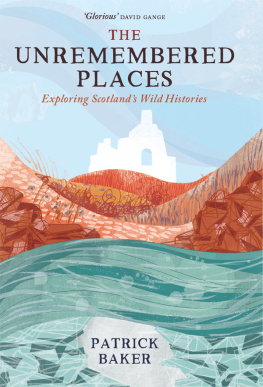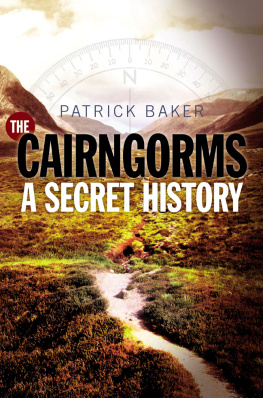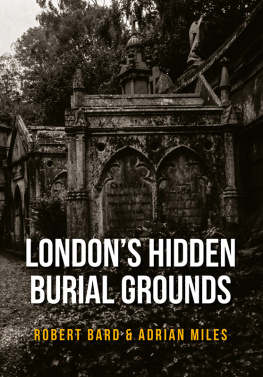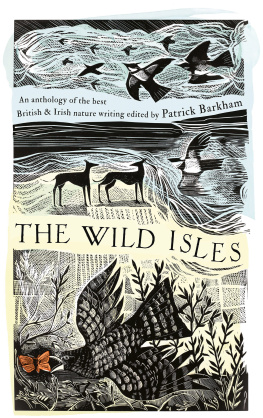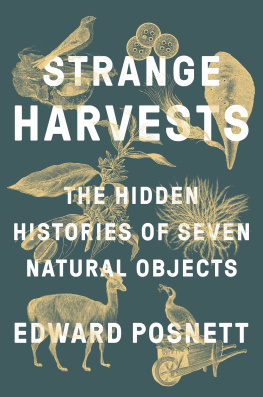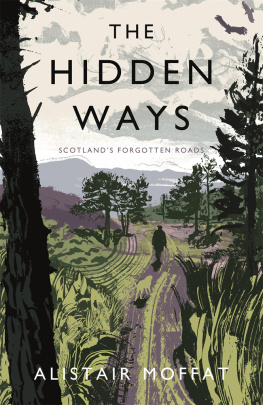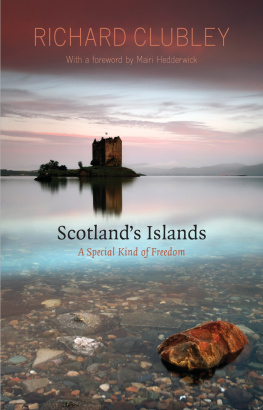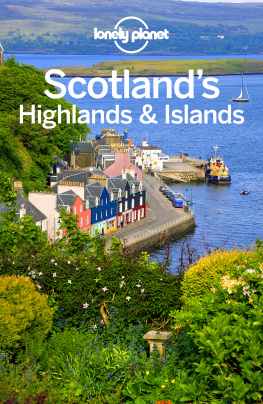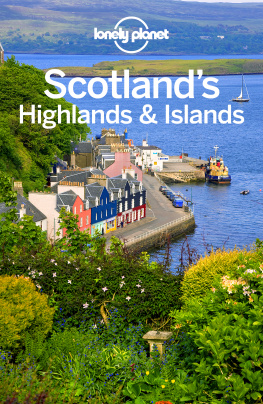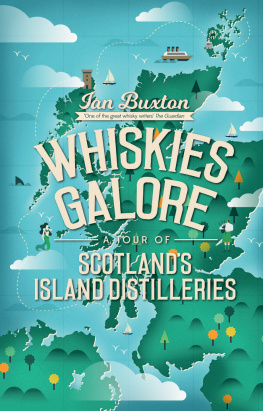Contents
Guide
THE UNREMEMBERED PLACES

First published in 2020 by
Birlinn Limited
West Newington House
10 Newington Road
Edinburgh
EH9 1QS
www.birlinn.co.uk
Copyright Patrick Baker 2020
The right of Patrick Baker to be identified as Author of this work has been asserted by him in accordance with the Copyright,
Designs and Patents Act 1988.
All rights reserved. No part of this publication may be reproduced,
stored or transmitted in any form without the express written permission of the publisher.
ISBN: 978 1 78885 266 1
British Library Cataloguing-in-Publication Data
A catalogue record for this book is available from the British Library.
Papers used by Birlinn are from well-managed forests and other responsible sources
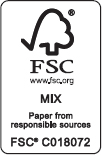
Typeset by Initial Typesetting Services, Edinburgh
Printed and bound by Clays Ltd, Elcograf S.p.A.
For Rachel and for Andrew
Contents
The Unwritten Places
The Glen Loin Caves, Succoth, Argyll and Bute
Blood and Concrete
The Blackwater Reservoir, Lochaber, West Highlands
The Memory Path
Jocks Road, Braemar to Glen Clova
Wild Island
Inishail, Loch Awe, Argyll and Bute and Eilean Fhianain, Loch Shiel, Lochaber, West Highlands
Land of the Left Behind
The Atlantic Wall, Sheriffmuir, Clackmannanshire and the Ardnamurchan Peninsula
Islands of Industry
The Slate Isles, Firth of Lorn, Inner Hebrides
Sea Fortress
Inchkeith, Firth of Forth
The Bone Caves
Inchnadamph, Assynt
Wood of the Ancient Well
Munlochy, the Black Isle
List of Illustrations
Air cruas nan creag
tha eagar smuaine,
air lom nam bean
tha n rann gun chluaine
On the hardness of rocks
is the ordered thought,
on the bareness of mountains
is the forthright verse
from Craobh nan Teud / The Tree of Strings
by Somhairle MacGill-Eain / Sorley MacLean
The Unwritten Places
The Glen Loin Caves, Succoth, Argyll and Bute
The words seem conspiratorial: secretive, colluding. I mumble them in a half-whisper, trying again to reference them on my map. Its no good. The directions are too vague, too inscrutable for precise placement. I found them online two months ago, and Ive been trying to decode them ever since. But maybe thats the point. They are deliberately equivocal, to deter the undetermined, maintain the elusiveness of the place.
Once in the glen, they instruct, take the forestry road northwards along the valley floor. When the track ends, carry on. Cross an area of broom and gorse, past a hill stream until you reach a high-voltage pylon. Find the narrow path (youll know it when you see it) and move uphill for a while. Look hard, and eventually you will spot them, not easily at first, but they are there, hidden amid a landslide of colossal boulders.
The torch beam bounces across the darkness, finding nothing. We keep walking, crunching out a kilometre or so on the rutted forestry track. Mist settles on my face in cold pinpricks, quickly drenching. From somewhere nearby theres the smell of peat smoke, pungent and sweet, lingering in the nostrils and sharp on the tongue. Clumsily we vault a gate, boots slipping on shiny aluminium, the sound of metal ringing in the blackness. I am with my friend Chris a willing accomplice in these kinds of ventures. We dont talk much; each of us puzzling the clues in the text, searching for a response in the landscape. Soon we have left the road and drifted into thick forestry: birch trees at first, their springy limbs whipping against us; then tightly packed pines, eye-level branches so sharp and brittle I walk with my hands in front of my face, flinching.
Were lost. Or at least, we have lost our way, turning circles in a dead end of rotten tree stumps and dank undergrowth. But then, from close by, I hear something. The purling notes of falling water. I move towards it, suddenly reinvigorated, clutching the soggy sheet of directions, looking for the hill stream. Instead I find a tiny burn; though its not even that. At best its a streamlet, a pathetic gurgle of water sluicing between tree trunks hardly the way-marker we have been looking for. The ground is soft, Ive sunk ankle-deep and my boots are now sodden. Im tired and Im thinking of returning in daylight, when Chris motions from a break in the treeline.
I know its there, even before I reach it. The air is charged, a fizzing hum that I can feel as much as I can hear. The pylon rises in a small clearing of heather and gorse as power lines angle in and out from above the tree-tops. We walk underneath the giant structure, and Im convinced that I can feel the loose energy intensify; a disturbing thrumming in my gums, and a prickling at my fingertips. We search the perimeters of the open ground and find what we are looking for. Part covered by low branches, we spot the beginnings of the path.
Theres no doubt now. The directions are right, and the sight of the path removes any uncertainty: its narrow and deeply gouged, a time-worn furrow, the result of decades, perhaps even centuries, of discreetly acquainted footfall. We scramble upwards, clutching at rocks and stepping between the knuckles of ancient tree roots. I can sense the passage of others here. The delicate tracery on the forest floor of those who have surreptitiously, knowingly, trodden these slopes before us: climbers, brigands, drovers, outlaws. And now, on this remote hillside, were searching for the same thing.

Although I cannot say when or how I first became aware of the Glen Loin Caves, it feels like they have always been there, hard-wired into my imagination. Most people will never have heard of them, but I have come to think of them in near-mythical terms: an unconfirmed place, conjured somehow within my consciousness over the years by the slow drip-feed of rumour and folklore. When their name occasionally surfaces, in stories about the early days of climbing or mentioned as the hideout for some dubious historical figure, it always stirs a strange restlessness in me.
There is something inherently beguiling about caves anyway, a powerful sense of attraction and foreboding. To consider entering a cave is to experience a conflict of feelings, a potent and contrary rush of curiosity and trepidation, inquisitiveness and apprehension. Caves are portals, breach points where the surface landscape is pierced and an inner world is reached. They are often retainers of mystery as well as space, an ingression into past happenings as much as they are themselves an ingression into the land.
The Glen Loin Caves are loaded with a similar duality, a peculiar and opposing combination of significance and secrecy. On the one hand is their historical importance. Among other claims, they were the reputed resting point for Robert the Bruce and his routed army in 1306 after his defeat at the Battle of Methven. More recently, the maze of fallen rocks on this Argyll mountainside was the focal point of a unique, sporting counterculture.

